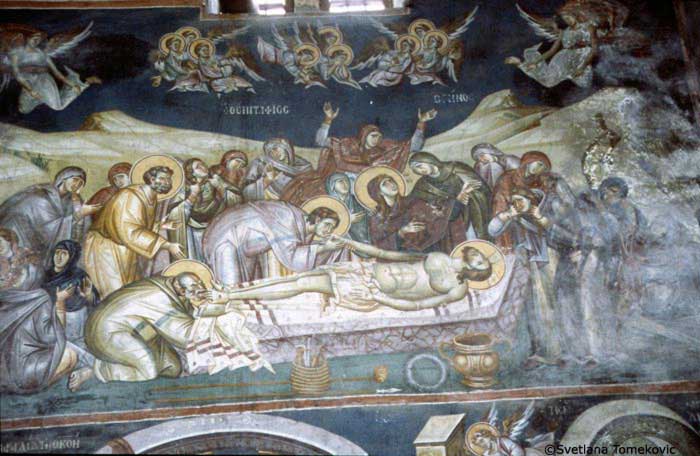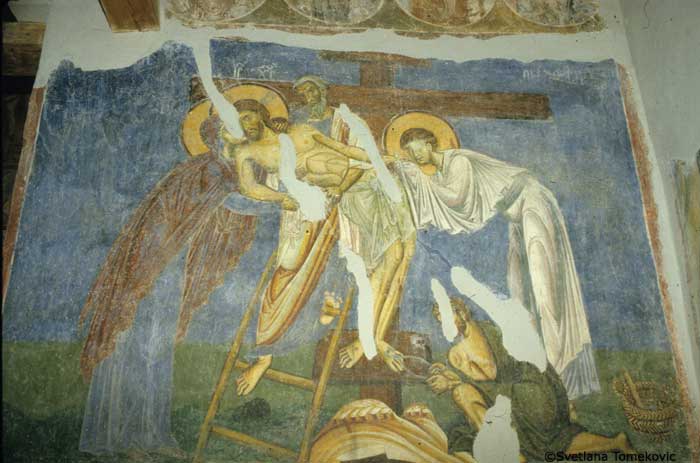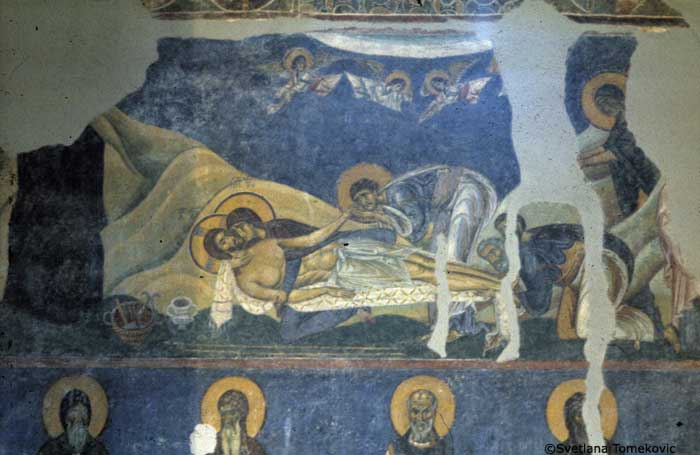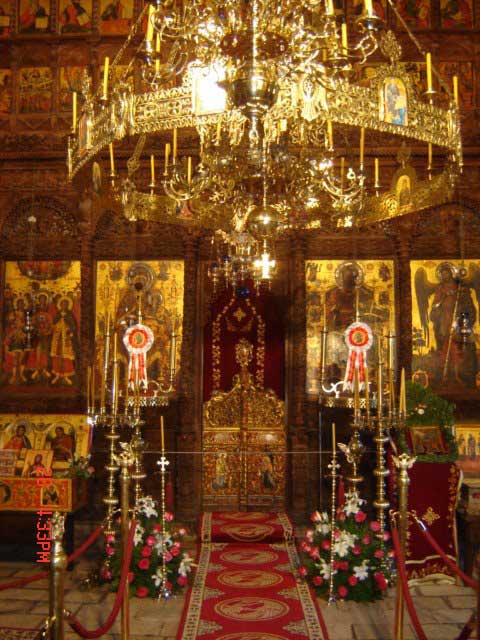The Macedonian people has re-established its church as one of the fundamental features of its national identity on the foundations of the Archbishopric of Ohrid. This autocephalous church has existed, first at Prespa and then in Ohrid, since the time of Czar Samuil and his descendants as the spiritual institution of that empire. It was legally strengthened by the Byzantine Emperor Basil II as an ecumenical Christian institution immediately after his defeat of Samuil’s state in 1018.
The administrative, economic and cultural measures then instituted by Byzantium were adapted to the local traditions. A leader of Slav Macedonian origin was retained at the head of the Archbishopric. At the time when the archiepiscopal leadership considered that the ecumenical Patriarchate in Nicaea had, at the beginning of the 13th century, infringed the autocephalous rights of the Archbishopric of Ohrid there was a fiery reaction from its Archbishop, Demetrius Homatian, who in large measure laid down the ecclesiastical and canonical aims of his ecclesiastical institution which would later be the canon law foundation for other archbishoprics as well.
In the 13th century at the time of the Bulgarian Emperor Ivan Asen II, in addition to the church at Trnovo, the older Ohrid Church was also an object of respect. This was also the case under the rule of the Serbian sovereign, Stefan Dushan: in addition to his church at Pec, he treated the Archbishopric of Ohrid with equal respect. After the proclamation of the Serbian Patriarchate in 1346 and its expulsion from the ecumenical body, the Patriarchate in Constantinople, the archbishops of Ohrid were engaged in a process of reconciliation for the return of Serbia into the orthodox community.
With the fall of Ohrid under Ottoman rule at the close of the 14th century the Archbishopric of Ohrid was legalized before the Turkish authorities and strengthened its rights, as had the Patriarchate of Constantinople after 1453, and for a period in the 15th century both the territory of Serbia and a part of Bulgaria came under its ecclesiastical jurisdiction.
In the Ottoman state the archbishops of Ohrid, particularly in the 17th and 18th centuries, took on the role of popular leaders in the movement for liberation, carrying on talks, predominantly with Austria, concerning the formation of a state for the captive Christians, primarily the Macedonians.
Despite the fact that Orthodox Albanians, Vlachs and Greeks from Epirus came into the Ohrid diocese in the course of the 18th century, all of these were deeply linked to the traditions of the Ohrid Church, guarding its autocephalous nature jealously. In the first half of the 18th century, therefore, virtually all the Lives and Services of the saints of its Church, starting with the Slavonic educators of the 9th and 10th centuries, were published in Macedonian Slavic.
In 1767, the financial difficulties of the Archbishopric of Ohrid were used as a pretext and it was discontinued by agreement of the Patriarchate of Constantinople and the Ottoman authorities. This dealt a grievous blow to the centuries-long ecclesiastical and cultural traditions maintained in Macedonia and the neighboring regions.
Throughout the long life of this extremely distinguished institution, lasting nearly eight centuries, the Archbishopric of Ohrid had not lost its autocephalous status, regardless of changes in the political situation under Byzantine, Bulgarian and Serbian rule or during the lengthy period of Ottoman Turkish rule. Other peoples and their parts of the Balkans had come under the diocese of the Archbishopric of Ohrid, which was extremely large, up to the 13th century and under Ottoman rule (15th and 16th centuries), but throughout the whole of its existence the Macedonians formed the basic zone of its eparchies and the main body of the faithful. The guardian and patron saint of the Church was the first pupil of Ss. Cyril and Methodius, St. Clement of Ohrid, one of the founders of Slavonic culture and literacy. His work was celebrated by distinguished Greek archbishops (e.g. Theophilact and Homatian), who respected the traditions of their flock, during the Byzantine period. The language of this institution of public worship was Slavonic, established by Ss. Cyril, Methodius and Clement and also ancient Greek which, together with Latin, was treated as a language of the entire Christian world.
In the cultural traditions of the Ohrid School, especially in its art, portraits of the first Slavonic educators from the 9th and 10th centuries have been created over a period of a thousand years, and many hundreds of representations of them have been preserved in churches. Macedonia was a center of the iconography of the old Slavonic period right up to the end of the 19th century.
The contact of the Macedonians with Byzantium, its culture, scholarship and art was a beneficial one. The Macedonians, like the Russians, Bulgarians, Serbs, Romanians and other peoples of the “Byzantine commonwealth”, as it has been termed by the distinguished British scholar D. Obolensky, made a great contribution in the middle ages to the development of the Byzantine style and culture through their own creative strengths, their outstanding writers, artists, builders, etc.
It is quite comprehensible that in the 19th century, in the struggle for cultural emancipation in Macedonia, the question of the revival of the Archbishopric of Ohrid was also posed. In the course of their struggle for their own language, the ecclesiastical and educational districts in Macedonia from the mid-19th century onwards sought also the revival of the ecclesiastical institution, which had been discontinued in 1767. Starting out from the fact that neither the Bulgarian nor the Serbian authorities had in earlier periods discontinued the Archbishopric of Ohrid, but rather recognized its autocephalous nature, there existed certain suppositions, both legal and ecclesiastical, concerning its revival; but the prevailing political and military conditions and above an the activities of neighboring propaganda rendered this impossible.
In the 20th century, during the period of the Second World War and the course of the military actions of the struggle for Macedonian statehood, the Macedonians put the question of an autocephalous church. In 1943, when the national liberation movement became a massive uprising and when the first liberated territory was established in the village of Izdeglavje in the Debar district of the Ohrid region, the First Assembly of Macedonian Clergy was held on 21st October and a decision was taken to form an Archpriests’ Governership with the aim of its developing into an autocephalous Macedonian church.
In October 1944, in the village of Gorno Vranovel in the Veles district, a Preliminary Committee for the organization of church life in Macedonia was formed. The first Church-and-People Assembly was held in Skopje in March 1945, when 300 delegates, all clergyman and laymen from whole of Macedonia declared themselves in favor of the realization of the aims expressed at Izdeglavje for the formation of an autocephalous Macedonian Orthodox Church with Macedonian Archiepriests. On 8th May 1946, only fourteen months after the first Church-and- People Assembly, a new Assembly of the Clergy took place in Skopje as a reaction to the fact that the decisions passed at the first Church-and-People Assembly had met with no understanding at the Holy Synod of the Serbian Orthodox Church.
Since the representatives of the Serbian orthodox Church were attempting to postpone the solution of the Macedonian Church question, the delegates to the second Church-and-People Assembly, held in Ohrid on 4th and 5h 0ctober 1958, passed a decision in favor of the revival of the Archbishopric of 0hrid and of the Constitution of the Macedonian orthodox Church, although with the recognition of the Patriarch of the Serbian Orthodox Church the Bishop of Toplice. Dositej was elected as its Archbishop, its supreme head.
After a year of negotiations, the Holy Synod of Archpriests of the Serbian Orthodox Church agreed to the secession of the three Macedonian eparchies order to form an independent Macedonian Church and stated that the regulations and the Constitution of the Serbian Orthodox Church ceased to be valid in the Macedonian Church. In accordance with this decision, the Serbian archpriests took part in the consecration of the first Macedonian archpriests. Patriarch German employs the title of Patriarch of Serbia and Macedonia.
Since the Serbian Church did not proclaim the state of affairs that had come to pass, the Holy Synod of the Macedonian Orthodox Church caned its third Church-and-People Assembly on 17th-18th July 1967 in Ohrid and discarded the personal union of the Macedonian and the Serbian Orthodox Churches. The Macedonian Orthodox Church is administered by an assembly and consists of the Eparchies of Skopje, Prespa and Bitola, Debar and Kicevo, Bregalnica, Polog and Kumanovo, Vardar, Strumica, the American and Canadian Eparchy and the Australian Eparchy, while a European Macedonian Eparchy is in the process of formation.
In its concern for the faithful beyond their fatherland, the Church endeavors to organize them into Macedonian church districts. The first such district came into being in 1958, immediately after the holding of the second Church-and-People Assembly. Today there are more than forty Macedonian church districts in the U.S.A. Canada, Australia and Europe in which virtually all the Macedonian emigrants are enrolled.
The education, training and renewal of the clergy of the Macedonian Orthodox Church is undertaken through the St. Clement of Ohrid Theological College, founded in 1964 and since 1977 a Theological Faculty has also been operative.

Virtual Macedonia
Republic of Macedonia Home Page
Here at Virtual Macedonia, we love everything about our country, Republic of Macedonia. We focus on topics relating to travel to Macedonia, Macedonian history, Macedonian Language, Macedonian Culture. Our goal is to help people learn more about the "Jewel of the Balkans- Macedonia" - See more at our About Us page.
Leave a comment || Signup for email || Facebook |
History || Culture || Travel || Politics




















